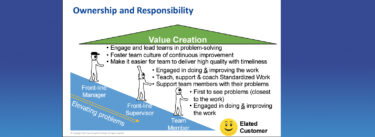Dear Gemba Coach,
How do you protect jobs while reducing lines and shifts?
That’s a real issue, and it doesn’t have a single answer. To be honest, the question hasn’t come up in practice that much, but it can, particularly when sales and operations are separated, and operations practices lean, but not sales.
True, real lean practice is about accelerating turns, so reducing inventories by increasing delivery frequency and reducing batches, which generally releases capacity as well as making the entire system more efficient. So what should we do with available capacity? Machines – just keep them idle, sell them if you can, or scrap them. People?
The question doesn’t come up so much because lean typically takes a few semesters to deliver sizeable changes. Early results come right away, but the organizational implications of this low hanging fruit are harder to come by, as management must figure our the “why?” of these results and draw the right conclusions and change their own management practices (unfortunately, in many cases, this shift from spot results to system results by a change of management choices never happens). This deeper change takes from one to three years.
In that period of time, natural turnover tends to compensate for positions being freed up by the improvement initiatives. Positions might be reduced, but not actual jobs for people. Then, most companies work with temps, and temporary positions can be reduced as well.
When senior managers draw the lessons from the early kaizen efforts and see the potential to transform the entire business they’re also pretty quick to see this will release free capacity that will now need to be filled up to avoid having to lay off any one. The obvious answer is: more sales.
Price vs. Product
At first, some of this happens naturally as better delivery and quality boost sales. But this early peak soon begs the real questions:
- Should we transfer some of the lean gains to customers and lower prices to generate volume? Not an easy question since lean transformations are rarely that neet and it takes time to figure how performance improvement translates into cost calculations. In my experience, this doesn’t happen by deciding to reduce price to go after more customers, but more by being able to align our prices to market conditions – the pressure was already there, and this means less lost business because of higher prices.
- Should we increase our product offering in order to sustain our prices and get more orders? This is the path companies I know generally try to take. This means a hard-nosed review of what products actually do for customers and how to improve both performance and features to make them more attractive.
In both cases, the key to your question lies in the ability to see lean across the full company. In case one, from operations to sales in order to translate quality improvement into selling points, and in case two from operations to engineering in order to translate greater flexibility in the ability to broaden the range and offer new alternatives for customers.
Protecting jobs is probably not the best way to frame the problem – if you start with the idea of protecting jobs, you’ll probably end up fighting on the side of the status quo, and the lean transformation won’t happen – the business will not become more competitive and jobs will be more at risk than ever.
Save Jobs by Creating Jobs
Nothing is ever static – the only way in business to save jobs is to create jobs, which means helping more customers with the service or product you provide. This, in turn, means seeing lean as a full business strategy, not a static local improvement method. To really see lean, you must look at customer value, value analysis, and value engineering:
- What do customers really value: what benefits do they get from working with you at what price – how can either benefits be increased or prices lowered?
- How can you improve value in today’s contracts? Using lean tools to improve value right now will tell you what customers are really looking for in your offer.
- How can you leverage this learning to improve future contracts? How can you design more value in your product or service to grow organically and convince customers to continue to purchase.
Sales are no longer about sales, but about resale – customers mostly have everything anyhow and switching costs are lower and lower. What can we do to convince them to repurchase with us? We need to provide more of what they like – which means that we need to change, all the time. Jobs can’t be protected because jobs need to evolve in order to continue to follow customers. People, however, can be assured of stable employment conditions if we find the way to grow the business by delivering more value.
Reducing line and shifts on product A might be necessary to fit production pace with sales pace. Overall, prospering means being to be able to shift seamlessly resources to product B, which entails (1) sales of product B and (2) the flexibility of producing both A and B on the same resources, which takes us back to increasing turns by improving flexibility.
What kind of lean are you looking at: are you seeking static optimizations here and there? Yes, local productivity improvement can put jobs at risk, particularly if done narrowly with the objective of reducing costs.
Lean as a full business strategy, however, will consider freeing capacity and growing sales as one and the same problem, two sides of the same coin. Lean thinking is explicit in starting with customer value, then looking at improving flexibility in value streams, then accelerating flows, then establishing pull to work at this daily, which creates opportunity for kaizen and to seek perfection. Perfection is not a steady state, it’s a dynamic value proposition.






